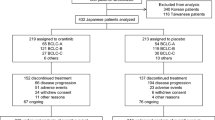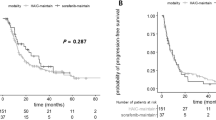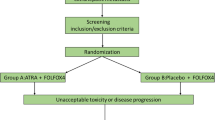Summary
We have previously reported that the combination of mitomycin C, carboquone, 5-fluorouracil and OK-432, including the intra-arterial administration of mitomycin C and carboquone (MQ-F-OK therapy), was effective in the treatment of advanced liver cancer. The Cooperative Study Group conducted a controlled study on MQ-F-OK therapy and the combination of mitomycin C, 5-fluorouracil and doxorubicin, including the intra-arterial administration of mitomycin C and doxorubicin (FAM therapy), against advanced liver cancer. Forty patients with advanced primary or secondary liver cancer were enrolled in this study and randomized into the MQ-F-OK group and the FAM group. Seventeen of the 21 cases in the MQ-F-OK group and 16 of the 19 cases in the FAM group were eligible for response evaluation in accordance with the criteria of the Japan Society for Cancer Therapy. There was no significant difference in the patient characteristics between the two groups. Three cases in the MQ-F-OK group and two in the FAM group showed partial response. There was, however, no significant difference in the response rates and the prolongation of life between the two groups. As for the side-effects, only anemia was observed more frequently in the FAM group than in the MQ-F-OK group. In conclusion, we could not preferentially recommend either MQ-F-OK therapy or FAM therapy for advanced liver cancer. The performance status of the patient was one of the most important factors in the treatment of advanced liver cancer because patients with poor performance status showed poorer results.
Similar content being viewed by others
References
Al-Idrissi HY, Ibrahim EM, Abdel Satir A, Satti MB, Al-Kasem S, Al-Qurain A (1985) Primary hepatocellular carcinoma in the eastern province of Saudi Arabia: treatment with combination chemotherapy using 5-fluorouracil, adriamycin and mitomycin C. Hepatogastoroenterology 32: 8–10
Aoyama M, Hirose H, Adachi N, Udo K, Oshima K, Kobayashi S (1981) Comparison of combination therapy of 5-fluorouracil, mitomycin C and adriamycin (FAM) and mitomycia C, 5-fluorouracil, and cytosine arabinoside (MFC) for advanced gastric cancer. Jpn J Cancer Chemother 8: 757–762
Falk RE, Greig P, Makowaka L, et al. (1982) Intermittent percutaneous infusion into the hepatic artery of cytotoxic drugs for hepatic tumours. Can J Surg 25: 47–50
Friedman MA, Vorbelding PA, Cassidy MJ, et al. (1979) Therapy for hepatocellular cancer with intrahepatic arterial adriamycin and 5-fluorouracil combined with whole liver irradiation: a Northern California Oncology Group Study. Cancer Treat Rep 63: 1885–1888
Heim N, Epelbaum R, Cohen Y, Robinson E (1984) Further studies on the treatment of advanced gastric cancer by 5-fluorouracil, adrimycin (doxorubicin), and mitomycin C (modified FAM). Cancer 54: 1999–2002
Japan Society for Cancer Therapy (1986) J Jpn Soc Cancer Ther 21: 929–942
Kubo Y, Shirai K, Hirai H, Abe M (1986) Present status of chemotherapy on hepatocellular carcinoma. Saishin Igaku 41: 594–599
MacDonald JS, Schein PS, Woolley PV, et al. (1980) 5-Fluorouracil, doxorubicin, and mitomycin C (FAM) combination chemotherapy for advanced gastric cancer. Ann Intern Med 93: 533–536
Melia WM, Johnson PJ, Williams R (1983) Induction of remission in hepatocellular carcinoma. Cancer 51: 206–210
Miyamoto H, Ogawa M, Inagaki J, et al. (1982) Arterial infusion of combination chemotherapy using adriamycin and mitomycin C for hepatoma and metastatic tumors of the liver. Jpn J Cancer Chemother 9: 1955–1960
Morstyn G, Bunn PA, Ihde DC, Eddy JL, Cohen MH, Minna JD (1983) Combination chemotherapy of hepatocellular carcinoma with doxorubicin and streptozotocin. Am J Clin Oncol 6: 547–551
Natsu-ume Sasaki S, Ryoyama K, Koshimura S, Migita S (1976) Studies on the properties of a streptococcal preparation OK-432 (NSC-B-116209) as an immunopotentiator. Jpn J Exp Med 46: 123–133
Ogawa M, Ito Y (1986) Chemotherapy for hepatoma. Sogo Rinsho 35: 1937–1939
Okamoto H, Shoin S, Koshimura S, et al. (1967) Studies on the anticancer and streptolysin S-forming abilities of hemolytic streptococci (a review). Jpn J Microbiol 11: 323–336
Sakata Y (1978) Effect of new trial MQF combination therapy against ascitic hepatic tumor cells- AH 7974, AH 130. Proc Jpn Cancer Ass 37th Annu Meet 1978, Tokyo, p 624
Sakata Y, Nishimura S, Komatsu Y, et al. (1979) The effect of the combination chemotherapy of mitomycin C, carboquone and 5-fluorouracil on the life span of the Hirosaki tetraploid sarcoma. Jpn J Cancer Clin 25: 1481–1482
Sakata Y, Sugawara K, Komatsu Y, Yoshida Y, Nishimura S, Kikuchi H (1979) Combination Chemotherapy of mitomycin C, carboquone, 5-fluorouracil and OK-432 for inoperable gastric cancer. J Jpn Soc Cancer Ther 14: 978–987
Sakata Y, Yoshida Y, Komatsu Y, et al. (1982) Studies on MQF-OK therapy against inoperable gastric cancer-Comparison with MFC therapy. Jpn J Cancer Chemother 9: 109–115
Sakata Y, Tsushima K, Suzuki H, et al. (1987) Prognostic factors prior to chemotherapy in patients with inoperable liver cancer. Hirosaki Med J 39: 395–399
Tanikawa K, Hirai K, Kawazoe Y, Yamashita K, Kumagai M, Abe M (1985) One-shot therapy and transcatheter arterial embolization (TAE) therapy for unresectable hepatocellular carcinoma. Jpn J Cancer Chemother 12: 1930–1937
Tsushima K, Sakata Y, Suzuki H, et al. (1984) The combination chemotherapy of mitomycin C, carboquone, 5-fluorouracil and OK-432 against inoperable liver cancer — including the method of intraarterial administration of MMC and CQ. Hirosaki Med J 36: 590–599
Ueoka H, Kuroda S, Ohnoshi T, et al. (1984) Intraarterial adriamycin for patients with hepatocellular carcinoma and metastatic liver carcinoma. Jpn J Cancer Chemother 11: 2579–2584
Yamada R, Sato M, Kawabata M, Nakatsuka H, Nakamura K, Takashima S (1983) Hepatic artery embolization in 120 patients with unresectable hepatoma. Radiology 148: 397–401
Wils J, Schalngen J, Naus A (1986) Phase II of hepatic artery Infusion with 5-fluorouracil, adriamycin, and mitomycin C (FAM) in liver metastases from colorectal carcinoma. Recent Results Cancer Res 100: 157–162
Author information
Authors and Affiliations
Rights and permissions
About this article
Cite this article
Sakata, Y., Komatsu, Y., Takagi, S. et al. Randomized controlled study of mitomycin C/carboquone/5-fluorouracil/OK-432 (MQ-F-OK) therapy and mitomycin C/5-fluorouracil/doxorubicin (FAM) therapy against advanced liver cancer. Cancer Chemother. Pharmacol. 23 (Suppl 1), S9–S12 (1989). https://doi.org/10.1007/BF00647230
Issue Date:
DOI: https://doi.org/10.1007/BF00647230




